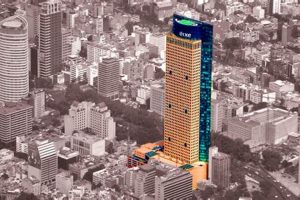Cleveland, Ohio, is a city on the southern shore of Lake Erie in the United States. It is the county seat of Cuyahoga County and the second-largest city in Ohio after Columbus. The city is known for its skyline, which is dominated by skyscrapers, including the Terminal Tower, Key Tower, and 200 Public Square.Cleveland’s skyscrapers are a testament to the city’s rich history and economic vitality. The Terminal Tower, completed in 1930, was once the tallest building in the United States outside of New York City. Key Tower, completed in 1991, is currently the tallest building in Ohio and the 17th-tallest building in the United States. 200 Public Square, completed in 1985, is the third-tallest building in Ohio and the 50th-tallest building in the United States.Cleveland’s skyscrapers offer stunning views of the city and Lake Erie. The Terminal Tower’s observation deck, located on the 42nd floor, offers 360-degree views of the city. Key Tower’s observation deck, located on the 57th floor, offers panoramic views of the city, Lake Erie, and the surrounding countryside. 200 Public Square’s observation deck, located on the 29th floor, offers views of the city, Lake Erie, and the Cuyahoga River.Cleveland’s skyscrapers are a major tourist attraction. Each year, thousands of visitors come to the city to see these architectural marvels. The Terminal Tower, Key Tower, and 200 Public Square are all open to the public, and visitors can take guided tours of the buildings.
1. Architecture
The architectural styles of Cleveland skyscrapers reflect the city’s rich history and its status as a major center of commerce and culture. The city’s skyscrapers exhibit a wide range of architectural styles, from the Art Deco grandeur of the Terminal Tower to the sleek modernism of Key Tower.
- Art Deco: The Terminal Tower, completed in 1930, is a prime example of the Art Deco style. This style is characterized by its geometric forms, stylized ornamentation, and bold colors. Other Art Deco skyscrapers in Cleveland include the Standard Oil Building (now the Ritz-Carlton Hotel) and the Guardian Building.
- International Style: The International Style emerged in the 1920s and 1930s as a reaction to the ornamentation of Art Deco. This style is characterized by its simplicity, functionality, and use of glass and steel. Examples of International Style skyscrapers in Cleveland include the BP Tower and the Huntington Bank Building.
- Modernism: Modernist architecture emerged in the mid-20th century and is characterized by its use of new materials and technologies, such as concrete, steel, and glass. Examples of Modernist skyscrapers in Cleveland include Key Tower and the 200 Public Square Building.
- Postmodernism: Postmodern architecture emerged in the 1960s and 1970s as a reaction to the austerity of Modernism. This style is characterized by its eclecticism, irony, and use of historical references. Examples of Postmodern skyscrapers in Cleveland include the Society for Savings Building and the Playhouse Square Center.
The diverse architectural styles of Cleveland skyscrapers reflect the city’s rich history and its status as a major center of commerce and culture. These skyscrapers are not only iconic landmarks but also important examples of architectural innovation.
2. Height
Key Tower’s height is a defining characteristic of Cleveland’s skyline and a testament to the city’s economic and architectural prowess. Here are four key facets that explore the connection between the height of Key Tower and Cleveland skyscrapers:
- Dominance of the skyline: Key Tower’s height makes it the most prominent building in Cleveland, dominating the city’s skyline and serving as a landmark visible from miles around. Its sheer height commands attention and contributes to Cleveland’s unique identity.
- Symbol of economic strength: Skyscrapers are often seen as symbols of economic power and prosperity. Key Tower’s height reflects Cleveland’s economic vitality and its status as a major business center in the Midwest. The building’s presence signifies the city’s ambition and drive for growth.
- Architectural achievement: Key Tower’s height is a testament to the skill and innovation of Cleveland’s architects and engineers. The building’s design and construction required cutting-edge techniques and materials, showcasing Cleveland’s commitment to architectural excellence.
- Tourist attraction: Key Tower’s height makes it a popular tourist attraction. Visitors can ascend to the building’s observation deck to enjoy panoramic views of the city and Lake Erie. The observation deck offers a unique perspective on Cleveland’s skyline and surrounding areas.
In conclusion, the height of Key Tower is not merely a physical attribute but a multifaceted symbol of Cleveland’s economic strength, architectural prowess, and appeal as a tourist destination. It is a testament to the city’s ambition, innovation, and commitment to progress.
3. Observation decks
Observation decks are an integral part of the experience of visiting Cleveland skyscrapers. They offer visitors a unique opportunity to take in the city’s stunning skyline and surrounding areas from a bird’s-eye view. The Terminal Tower, Key Tower, and 200 Public Square all have observation decks that are open to the public, and each offers its unique perspective on the city.
The Terminal Tower’s observation deck is located on the 42nd floor, and it offers 360-degree views of the city. Visitors can see the city’s downtown core, the Cuyahoga River and Valley, and Lake Erie. The Key Tower’s observation deck is located on the 57th floor, and it offers panoramic views of the city, Lake Erie, and the surrounding countryside. 200 Public Square’s observation deck is located on the 29th floor, and it offers views of the city, Lake Erie, and the Cuyahoga River.
Observation decks are a popular tourist attraction in Cleveland, and they offer a great way to experience the city’s skyline and architecture. They are also a great place to take photos and capture the beauty of the city.
4. History
The Terminal Tower is a defining element of Cleveland’s skyline and a significant piece of the city’s architectural heritage. Its historical significance is intertwined with the development of Cleveland skyscrapers, making it a valuable component of the city’s built environment.
Upon i
ts completion in 1930, the Terminal Tower became the tallest building in the United States outside of New York City. This achievement showcased Cleveland’s economic strength and architectural ambition during a period of rapid urban growth. The Terminal Tower’s design, influenced by Art Deco and Gothic Revival styles, reflected the architectural trends of its time and set a precedent for future skyscraper construction in Cleveland.
Beyond its architectural significance, the Terminal Tower has played a vital role in the city’s transportation and business sectors. It was built as part of the Cleveland Union Terminal, a major transportation hub that connected rail, bus, and air travel. The Terminal Tower’s proximity to these transportation links contributed to its importance as a business center and helped shape the development of Cleveland’s downtown area.
Today, the Terminal Tower remains a prominent landmark and a popular tourist attraction. Its observation deck offers panoramic views of the city, making it an ideal spot for visitors to appreciate Cleveland’s skyline and architectural heritage. The Terminal Tower’s historical significance and enduring presence continue to contribute to its status as a beloved icon of Cleveland.
5. Engineering
Cleveland skyscrapers are not just architectural marvels; they are also feats of engineering, designed to withstand the region’s challenging climate. The city experiences cold winters, hot summers, and unpredictable weather patterns, so buildings must be constructed to endure these extreme conditions.
- Structural integrity: Skyscrapers in Cleveland are built with robust frameworks and foundations to withstand strong winds and seismic activity. Engineers use advanced materials and techniques to ensure that buildings can resist lateral forces and maintain their structural integrity.
- Facade design: The exterior facades of Cleveland skyscrapers are designed to protect the building from the elements. Cladding materials, such as glass, metal, and concrete, are carefully selected for their durability and resistance to temperature fluctuations, moisture, and UV radiation.
- Mechanical systems: Skyscrapers in Cleveland are equipped with sophisticated mechanical systems to regulate temperature, humidity, and air quality. These systems ensure that occupants are comfortable and productive throughout the year, regardless of the outdoor conditions.
- Sustainability: Newer skyscrapers in Cleveland incorporate sustainable design elements to reduce their environmental impact. Green roofs, rainwater harvesting systems, and energy-efficient lighting are becoming increasingly common, contributing to the city’s commitment to sustainability.
The engineering behind Cleveland skyscrapers is a testament to the skill and innovation of the city’s architects and engineers. These buildings are not only beautiful, but they are also safe, durable, and sustainable, ensuring that they will continue to be landmarks on the Cleveland skyline for years to come.
6. Economic impact
Skyscrapers are not just architectural marvels; they are also economic powerhouses that drive the growth and prosperity of cities. Cleveland skyscrapers are no exception. They house a diverse range of businesses, from Fortune 500 companies to small startups, contributing significantly to the city’s economy.
- Job creation: Skyscrapers provide employment opportunities for thousands of people in Cleveland. From architects and engineers to construction workers and maintenance staff, these buildings support a wide range of jobs.
- Tax revenue: Skyscrapers generate substantial tax revenue for the city of Cleveland. Property taxes, income taxes, and sales taxes all contribute to the city’s budget, which is used to fund essential services and infrastructure.
- Business growth: Skyscrapers provide businesses with the space and resources they need to grow and succeed. Class-A office space, state-of-the-art amenities, and access to transportation hubs make Cleveland skyscrapers attractive to both domestic and international companies.
- Urban revitalization: Skyscrapers can play a catalytic role in urban revitalization. By attracting businesses and investment to downtown areas, skyscrapers can help to revitalize struggling neighborhoods and create a more vibrant and prosperous city.
The economic impact of Cleveland skyscrapers is undeniable. They are not just iconic landmarks; they are engines of economic growth that contribute to the city’s prosperity and well-being.
7. Tourism
Cleveland’s skyscrapers are not just architectural marvels and economic powerhouses; they are also major tourist attractions that draw visitors from around the world.
- Architectural beauty: Cleveland’s skyscrapers are renowned for their stunning architecture, showcasing a wide range of styles from Art Deco to modern. Visitors can admire the intricate details and soaring heights of these buildings, which have become iconic symbols of the city.
- Observation decks: Several of Cleveland’s skyscrapers offer observation decks that provide breathtaking panoramic views of the city and Lake Erie. Visitors can ascend to these decks to experience the city from a unique perspective and capture stunning photographs.
- Cultural significance: Cleveland’s skyscrapers are not just buildings; they are also cultural landmarks that reflect the city’s history and identity. Visitors can learn about the stories behind these buildings and their role in shaping Cleveland’s urban landscape.
- Economic impact: Tourism plays a significant role in Cleveland’s economy, and skyscrapers are a major attraction for visitors. The revenue generated from tourism supports local businesses and contributes to the city’s overall economic growth.
In conclusion, Cleveland’s skyscrapers are not just architectural wonders or economic engines; they are also important tourist attractions that contribute to the city’s cultural identity and economic vitality. Visitors from around the world come to Cleveland to admire the beauty of these buildings and experience the stunning views from their observation decks, making them an integral part of the city’s tourism industry.
8. Urban planning
Skyscrapers play a significant role in shaping the urban landscape and creating a city’s unique identity. In Cleveland, skyscrapers have been instrumental in defining the city’s skyline and contributing to its overall aesthetic appeal.
- Creating a distinct skyline: Cleveland’s skyscrapers are a defining feature of the city’s skyline, creating a visually striking and recognizable cityscape. The height and architectural diversity of these buildings contribute to a dynamic and ever-changing skyline that attracts attention and sets Clevelan
d apart from other cities. - Establishing focal points and landmarks: Skyscrapers can serve as focal points and landmarks within a city, providing orientation and a sense of place. In Cleveland, the Terminal Tower and Key Tower are iconic skyscrapers that serve as landmarks, helping people navigate the city and creating a sense of identity and pride.
- Enhancing the urban experience: Skyscrapers can enhance the urban experience by creating vibrant and active street-level environments. The presence of skyscrapers encourages pedestrian traffic, supports retail and dining options, and contributes to a lively and engaging urban atmosphere.
- Promoting sustainable urban development: Modern skyscrapers are increasingly designed with sustainability in mind, incorporating energy-efficient features and green spaces. In Cleveland, newer skyscrapers like the 200 Public Square Building showcase sustainable design practices, contributing to the city’s environmental goals and creating a more livable urban environment.
In conclusion, Cleveland’s skyscrapers play a vital role in shaping the city’s urban landscape and contributing to its overall aesthetic appeal. They create a distinct skyline, establish focal points and landmarks, enhance the urban experience, and promote sustainable urban development. As Cleveland continues to grow and evolve, its skyscrapers will undoubtedly continue to play a significant role in defining the city’s identity and creating a vibrant and livable urban environment.
9. Sustainability
In the realm of architecture and urban planning, sustainability has become an increasingly important consideration. Newer skyscrapers, including those in Cleveland, are embracing sustainable design elements to reduce their environmental impact and contribute to a more sustainable built environment.
One key aspect of sustainable skyscraper design is energy efficiency. Newer buildings are incorporating energy-efficient features such as high-performance glazing, LED lighting, and smart building management systems to reduce energy consumption. The 200 Public Square Building in Cleveland, for example, is LEED Gold certified and features a double-skin facade that helps regulate the building’s temperature and reduces energy use.
Another important aspect of sustainable skyscraper design is the use of renewable energy sources. Some newer skyscrapers are equipped with solar panels or wind turbines to generate renewable energy and reduce their reliance on fossil fuels. The Key Tower in Cleveland is exploring the feasibility of installing wind turbines on its upper floors to generate renewable energy.
Sustainable skyscraper design also involves the use of sustainable materials and construction practices. Newer buildings are increasingly using recycled and renewable materials, and employing construction methods that minimize waste and pollution. The Terminal Tower in Cleveland, while not a new skyscraper, has undergone renovations to incorporate sustainable features such as energy-efficient lighting and low-flow plumbing fixtures.
The incorporation of sustainable design elements in newer Cleveland skyscrapers is not only beneficial for the environment but also has practical significance. Sustainable buildings can lower operating costs, improve occupant health and well-being, and contribute to the city’s overall sustainability goals. By embracing sustainable design, Cleveland is positioning itself as a leader in sustainable urban development and creating a more livable and sustainable city for its residents and visitors.
FAQs on Cleveland Skyscrapers
Cleveland’s skyscrapers are iconic landmarks that define the city’s skyline and contribute to its economic vitality. Here are answers to some frequently asked questions about these architectural marvels:
Question 1: What is the tallest skyscraper in Cleveland?
Answer: Key Tower, standing at 947 feet tall, is the tallest skyscraper in Cleveland and the 17th-tallest building in the United States.
Question 2: What is the oldest skyscraper in Cleveland?
Answer: The Old Stone Church, built in 1855, is the oldest surviving skyscraper in Cleveland. While not as tall as modern skyscrapers, it is a significant historical landmark.
Question 3: How many skyscrapers are in Cleveland?
Answer: There are over 100 skyscrapers in Cleveland, with more than 20 standing over 500 feet tall.
Question 4: Can the public visit any of the skyscrapers in Cleveland?
Answer: Yes, several skyscrapers in Cleveland offer observation decks open to the public. The Terminal Tower, Key Tower, and 200 Public Square all have observation decks with stunning views of the city.
Question 5: What is the economic impact of skyscrapers in Cleveland?
Answer: Skyscrapers in Cleveland house businesses, generate tax revenue, create jobs, and contribute to the city’s overall economic growth and prosperity.
Question 6: Are there any sustainable skyscrapers in Cleveland?
Answer: Yes, newer skyscrapers in Cleveland incorporate sustainable design elements such as energy-efficient lighting, renewable energy sources, and sustainable materials to reduce their environmental impact.
In conclusion, Cleveland’s skyscrapers are not only architectural wonders but also important economic and cultural landmarks that contribute to the city’s identity and prosperity.
Transition to the next article section:
Explore the architectural diversity of Cleveland’s skyscrapers in the next section.
Tips on Cleveland Skyscrapers
Cleveland’s skyscrapers are architectural marvels that offer stunning views, rich history, and unique experiences. Here are five tips to enhance your appreciation and enjoyment of these iconic buildings:
Tip 1: Visit observation decks for breathtaking views: The Terminal Tower, Key Tower, and 200 Public Square offer observation decks with panoramic vistas of the city and Lake Erie. Capture stunning photographs and soak in the beauty of Cleveland’s skyline from these elevated vantage points.
Tip 2: Explore the architectural diversity: Cleveland’s skyscrapers showcase a range of architectural styles, from Art Deco to modern. Take time to admire the intricate details and unique designs of each building, appreciating the artistry and engineering that went into their creation.
Tip 3: Learn about the history and significance: Each skyscraper has a unique story to tell. Research their history, architects, and the role they played in shaping Cleveland’s urban landscape. Discover the stories behind these architectural icons.
Tip 4: Appreciate the engineering marvels: Cleveland’s skyscrapers are feats of engineering, designed to withstand the region’s climate and seismic activity. Marvel at the structural integrity, innovative materials, and advanced construction techniques that make these buildings safe and durable.
Tip 5: Consider sustainability features: Newer skyscrapers in Cleveland incorporate sustainable design elements, such as energy-efficient lighting, renewable energy sources, and sustainable materials. Learn about the innovative approaches taken to reduce the environmental impact of these architectural giants.
By following these tips, you can deepen your understanding and appreciation of Cleveland’s skyscrapers, turning your visit into a truly enriching experience.
Transition
to the article’s conclusion:
Cleveland’s skyscrapers are not just architectural wonders but also testaments to the city’s rich history, economic vitality, and commitment to progress. By embracing these tips, you can fully immerse yourself in the beauty, history, and significance of these iconic landmarks.
Cleveland Skyscrapers
Cleveland’s skyscrapers are not just architectural wonders; they are also economic powerhouses that drive the growth and prosperity of the city. These iconic buildings house a diverse range of businesses, from Fortune 500 companies to small startups, creating employment opportunities and generating substantial tax revenue. By attracting businesses and investment to downtown areas, skyscrapers play a catalytic role in urban revitalization, contributing to a more vibrant and prosperous Cleveland.
Beyond their economic impact, Cleveland’s skyscrapers are also symbols of the city’s rich history and cultural heritage. The Terminal Tower, completed in 1930, stands as a testament to the city’s industrial past and architectural ambition. Newer skyscrapers, such as Key Tower and 200 Public Square, showcase innovative design and sustainable practices, reflecting Cleveland’s commitment to progress and sustainability. Together, these architectural marvels shape the city’s skyline, creating a distinctive and recognizable urban landscape.
Cleveland’s skyscrapers are more than just buildings; they are symbols of the city’s economic vitality, architectural prowess, and commitment to growth. As the city continues to evolve, its skyscrapers will undoubtedly continue to play a significant role in shaping its future and contributing to its prosperity.







